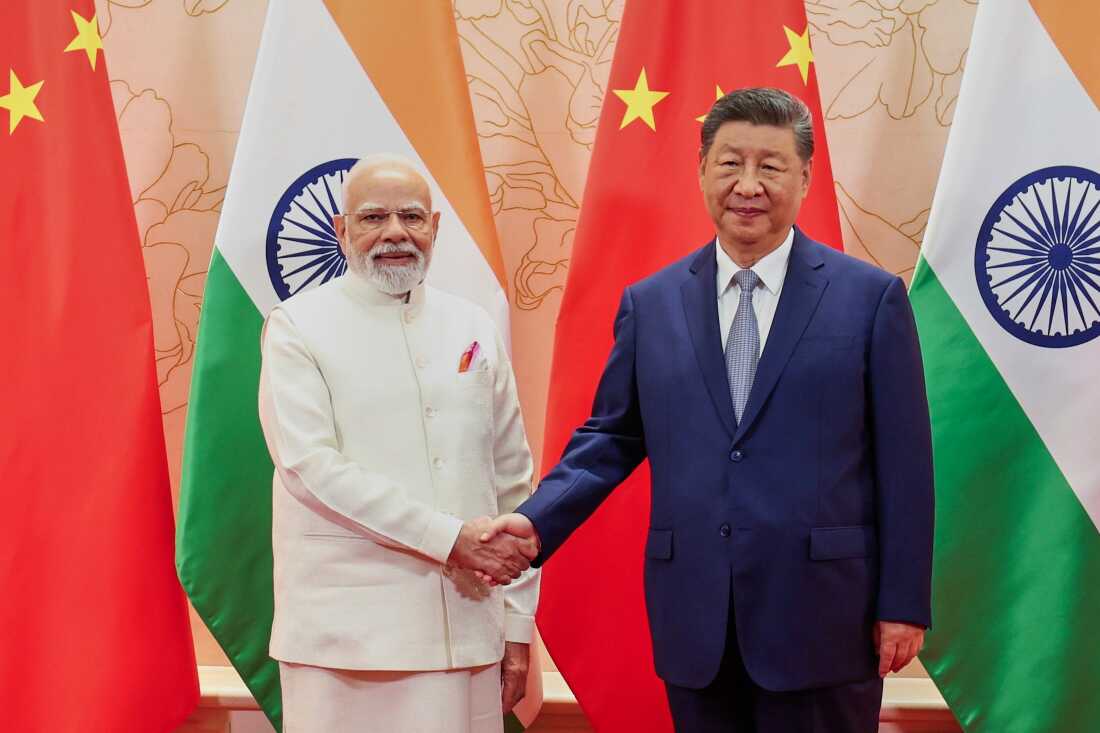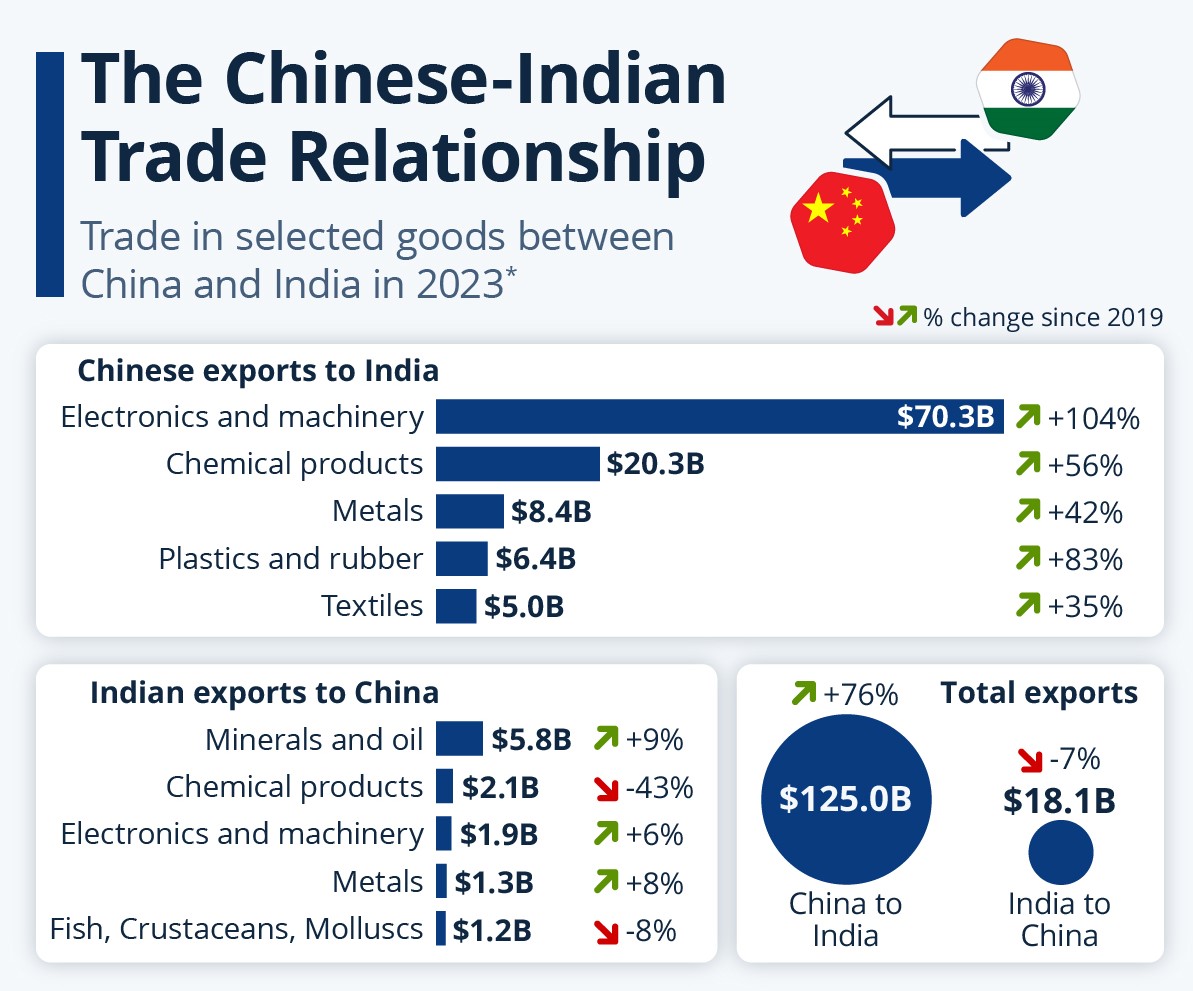Context:
Prime Minister Narendra Modi met Chinese President Xi Jinping in Tianjin on August 31, 2025, marking his first visit to China in seven years. The meeting took place on the sidelines of the Shanghai Cooperation Organisation (SCO) Summit, where other key leaders, including Russian President Vladimir Putin and Pakistani Prime Minister Shehbaz Sharif, were also present.
-
-
The talks came against the backdrop of renewed efforts to stabilise India–China ties after years of strain, particularly following the violent Galwan Valley clashes of 2020. Both sides highlighted the need for peace on the border and reaffirmed their commitment to cooperation based on “mutual respect, mutual interest, and mutual sensitivity.” However, differences in emphasis—particularly on the border dispute—indicate that the relationship remains fragile.
-
Historical Backdrop
· Border Dispute: India and China share a 3,488 km-long disputed boundary known as the Line of Actual Control (LAC). Key friction points include Eastern Ladakh, Aksai Chin (occupied by China but claimed by India), and Arunachal Pradesh (controlled by India but claimed by China as “South Tibet”).
· Past Conflicts: The 1962 Sino–Indian War was followed by border skirmishes in 1967 (Nathu La, Cho La) and 1987 (Sumdorong Chu). While the 1993 and 1996 border agreements institutionalised peace, they did not resolve the dispute.
· Galwan 2020: The first deadly clash in 45 years killed 20 Indian soldiers and 4 Chinese troops (China’s official admission). This shattered trust and brought ties to their lowest point in decades.
India responded by:
· Restricting Chinese FDI under the automatic route.
· Banning over 300 Chinese apps citing national security.
· Diversifying supply chains away from Chinese imports.
Key Outcomes of the Tianjin Meeting:
1. Border Issue
· Both sides stressed the importance of maintaining “peace and tranquility” along the LAC.
· China signalled that the border dispute should not define the entire relationship.
· India underlined that peace on the border is a prerequisite for progress in other areas—a subtle but important distinction.
2. Strategic Autonomy
India reiterated that its relationship with China should not be seen through the prism of third countries. This reflects India’s long-standing policy of non-alignment, though Beijing has often suspected India of tilting toward the United States or Russia to counterbalance China.
3. Trade and Investment
The Indian side called for expanding bilateral trade and reducing the large deficit. While both countries acknowledged economic cooperation, no new mechanisms were finalised. A 2019 plan to set up a high-level mechanism on trade never materialised due to the pandemic and border tensions.
Recent Agreements: Building Blocks for Normalisation:
Alongside the leaders’ meeting, India and China announced a set of practical agreements aimed at rebuilding trust:
1. Resumption of Direct Flights
o An updated Air Services Agreement will restore direct passenger and cargo flights between the two countries, suspended since the pandemic.
2. Reopening of Border Trade
o Trade routes through Lipulekh (Uttarakhand), Shipki La (Himachal Pradesh), and Nathu La (Sikkim) will reopen. These routes are vital for Himalayan border communities and have symbolic importance for confidence-building.
3. Working Group on Border Management
o Under the Working Mechanism for Consultation and Coordination (WMCC), a new group will strengthen communication, reduce risks of accidental escalation, and manage patrolling along the LAC.
Motivations Behind the Thaw:
China’s Motivations
· Economic Pressures: Slowing growth, industrial overcapacity, and post-COVID recovery challenges compel Beijing to seek stable regional ties.
· Strategic Calculations: With tensions rising with the US, China aims to avoid simultaneous confrontation with India.
· Regional Balancing: By re-engaging India, China seeks to limit New Delhi’s reliance on the Quad (India, US, Japan, Australia).
India’s Motivations
· Security Priorities: De-escalating border tensions allows India to focus on domestic economic growth and infrastructure.
· Diversification of Ties: Engagement with China helps India balance its foreign policy without being overly dependent on any one bloc.
· Pragmatic Vigilance: India continues to invest in border infrastructure and strategic partnerships while cautiously reopening dialogue.
Implications of the New Phase:
1. Economic Cooperation
· Resumed flights and trade routes may revitalise supply chains and regional economies.
· However, India must address its trade deficit and avoid overdependence on Chinese imports, particularly in critical sectors like electronics and pharmaceuticals.
2. People-to-People Exchanges
· Easier travel and visas could boost tourism, education, and cultural exchanges, restoring social trust at the grassroots level.
3. Border Stability
· A structured working group can reduce accidental confrontations and prevent escalation similar to Galwan.
Risks and Challenges:
1. Unresolved Border Disputes:
o Areas like Eastern Ladakh, Aksai Chin, and Arunachal Pradesh remain contested.
o Past disengagements have been temporary, raising the risk of future standoffs.
2. China’s Opportunism:
o Beijing’s record of unilateral moves—such as building border outposts or issuing maps claiming Indian territory—raises doubts about its commitment.
3. Security Concerns in Trade and Connectivity:
o Reopening routes could increase risks of espionage, smuggling, and surveillance.
4. Geopolitical Competition:
o China’s growing influence in South Asia through the Belt and Road Initiative (BRI) remains a challenge to India’s regional leadership.
RIC Troika:
The revival of the Russia–India–China (RIC) trilateral adds another layer to the dynamics. Initially conceptualised in the 1990s, RIC aims to counter Western dominance and promote multipolarity. Together, the three countries represent one-third of global GDP and nearly 38% of the world’s population.
· Drivers of Revival: US tariffs, Western sanctions on Russia, and the weaponisation of the dollar have incentivised trilateral cooperation.
· Strategic Significance: Offers leverage in global governance, strengthens India’s UNSC prospects, and supports Eurasian connectivity.
· Challenges: India–China mistrust, divergent foreign policy goals, and China’s economic dominance limit the grouping’s effectiveness.
Despite its limitations, RIC remains a useful platform for India to maintain Eurasian relevance while avoiding isolation.
Broader Significance
For the Indo-Pacific
Improved India–China ties could reduce regional instability. However, India must ensure this does not dilute its Indo-Pacific partnerships with democratic allies.
For Global Geopolitics
India’s ability to manage relations with China while deepening ties with the US, Europe, and other partners reinforces its position as a swing player in global diplomacy. A constructive India–China relationship can enhance New Delhi’s bargaining power—but only if managed carefully.
Conclusion:
The Tianjin meeting marks a cautious attempt at stabilising India–China relations after years of mistrust. Steps such as reopening trade routes, resuming flights, and creating a border management working group reflect mutual recognition that hostility benefits neither side.
| UPSC Main Question: India–China relations have oscillated between cooperation and confrontation in the past decade. Critically examine the motivations behind the recent revival of economic and diplomatic engagement, and assess the risks and opportunities it presents for India’s strategic autonomy. |








